Abstract
The aim of this study was to determine whether a very high-risk group based on presenting characteristics could be identified in patients with advanced Hodgkin's disease who may benefit from high-dose chemotherapy (HDCT). Between 1975 and 1992, 453 previously untreated patients aged under 60 years who did not progress in the first 6 months after the start of standard chemotherapy had their hospital notes reviewed. The outcomes analysed were early disease progression (in the 6- to 18-month window following the start of chemotherapy) and disease progression in the whole of the follow-up period. A Cox regression analysis was used to investigate the combined effects of a number of presenting characteristics on these outcomes. Despite the presence of factors with significant effects on the relative rate of progression, the absolute effects in a group identified as having the poorest prognosis were not especially poor. No group could be defined with a freedom from progression rate of less than 70% over 6-18 months, and the worst prognostic group, which included only 53 patients, had an overall freedom from progression rate of 57% at 5 years. Four other reported prognostic indices were evaluated using our data set, but none of the indices was more successful in identifying a very high-risk group. It has not been possible to define a sufficiently high-risk group of patients with Hodgkin's disease based on presenting characteristics for whom HDCT could be advised as part of primary treatment. The search for more discriminating prognostic factors identifying vulnerable patients with a high risk of relapse must continue before a role can be found for HDCT following conventional chemotherapy in patients without disease progression.
Full text
PDF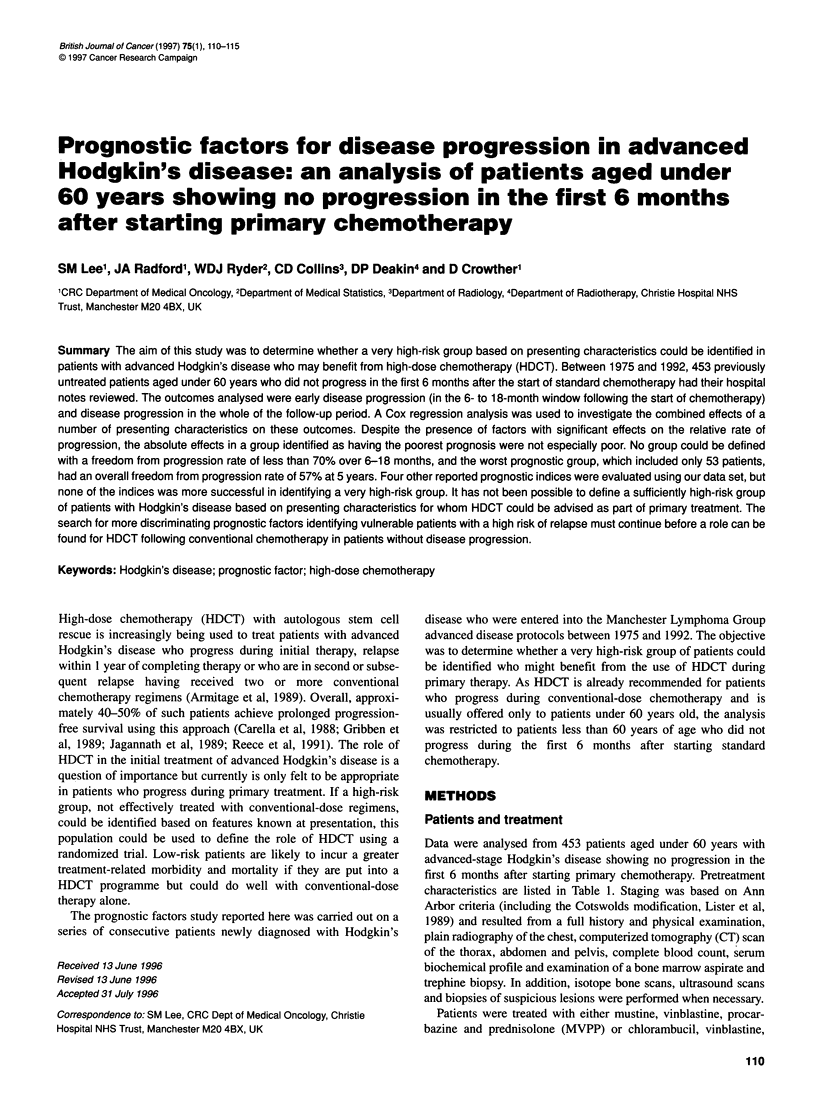
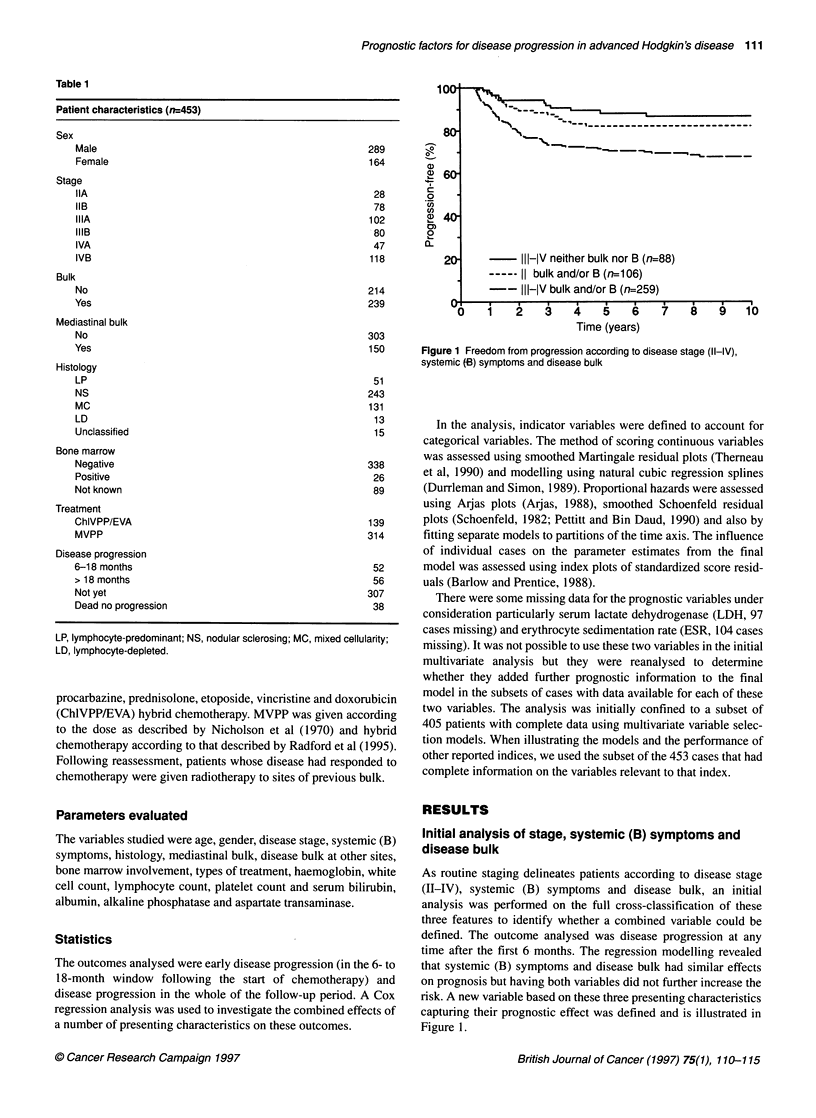
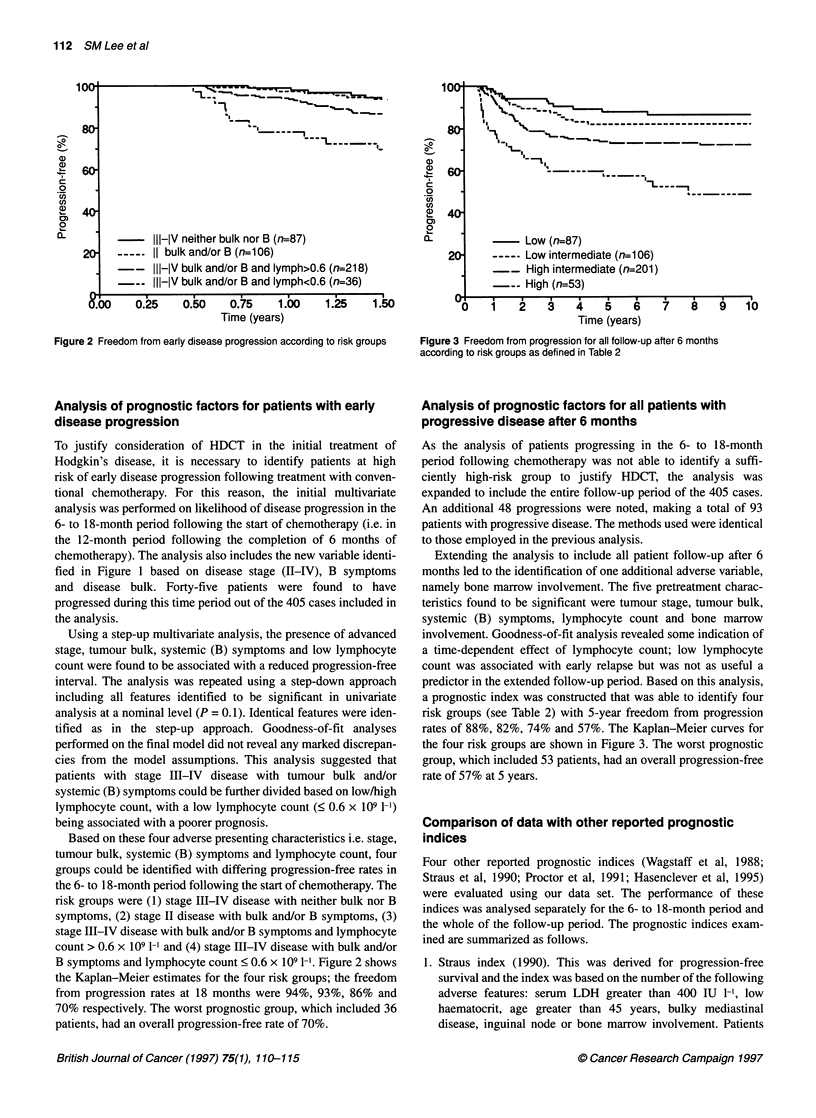
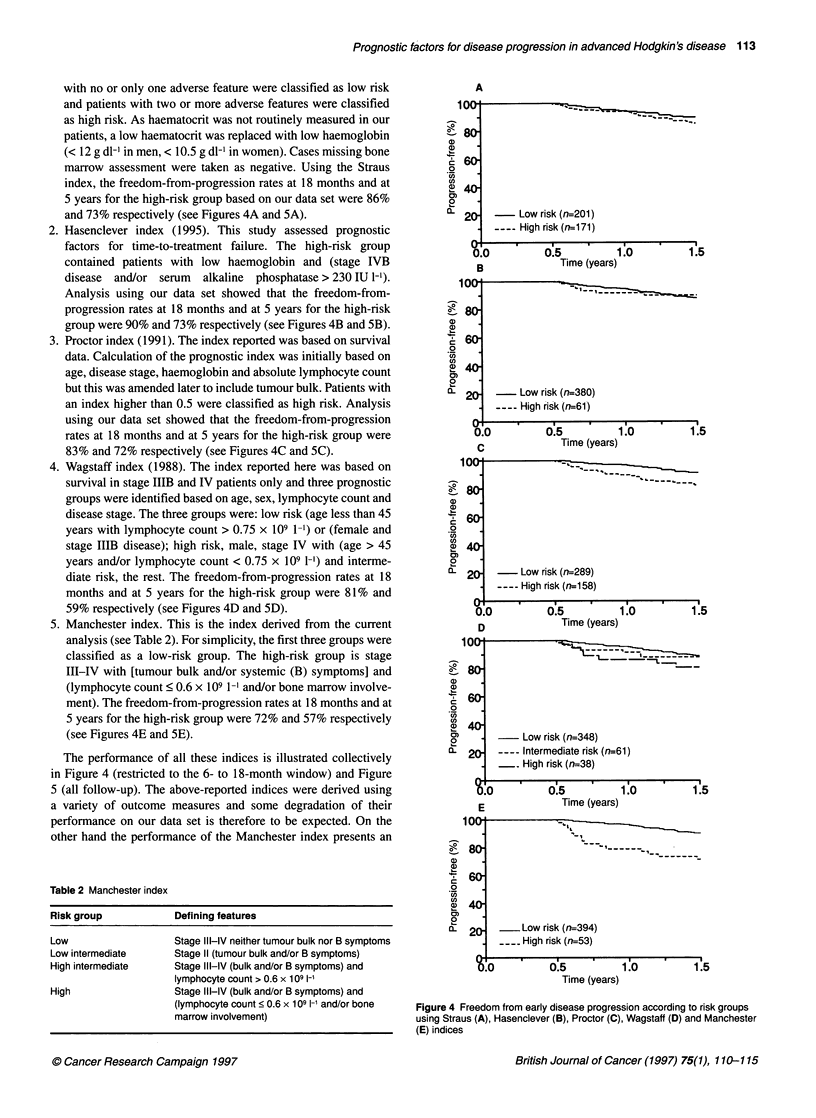
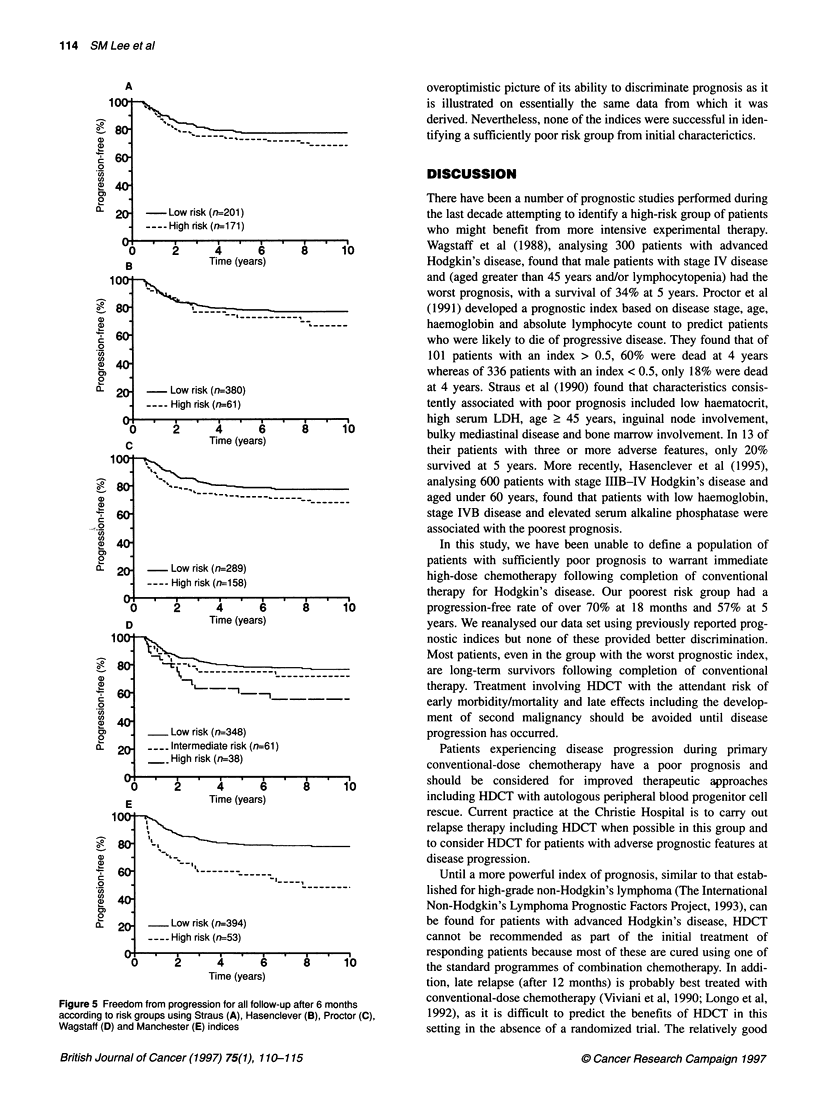
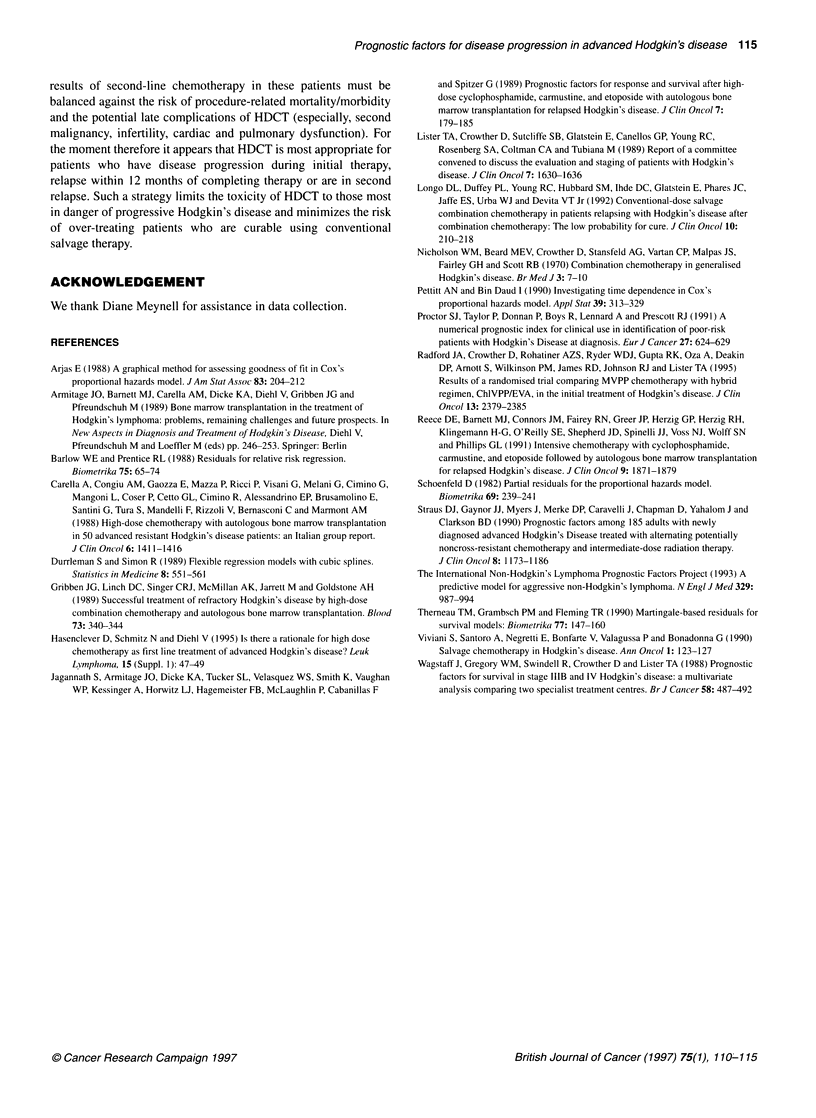
Selected References
These references are in PubMed. This may not be the complete list of references from this article.
- Armitage J. O., Barnett M. J., Carella A. M., Dicke K. A., Diehl V., Gribben J. G., Pfreundschuh M. Bone marrow transplantation in the treatment of Hodgkin's lymphoma: problems, remaining challenges, and future prospects. Recent Results Cancer Res. 1989;117:246–253. doi: 10.1007/978-3-642-83781-4_28. [DOI] [PubMed] [Google Scholar]
- Carella A. M., Congiu A. M., Gaozza E., Mazza P., Ricci P., Visani G., Meloni G., Cimino G., Mangoni L., Coser P. High-dose chemotherapy with autologous bone marrow transplantation in 50 advanced resistant Hodgkin's disease patients: an Italian study group report. J Clin Oncol. 1988 Sep;6(9):1411–1416. doi: 10.1200/JCO.1988.6.9.1411. [DOI] [PubMed] [Google Scholar]
- Durrleman S., Simon R. Flexible regression models with cubic splines. Stat Med. 1989 May;8(5):551–561. doi: 10.1002/sim.4780080504. [DOI] [PubMed] [Google Scholar]
- Gribben J. G., Linch D. C., Singer C. R., McMillan A. K., Jarrett M., Goldstone A. H. Successful treatment of refractory Hodgkin's disease by high-dose combination chemotherapy and autologous bone marrow transplantation. Blood. 1989 Jan;73(1):340–344. [PubMed] [Google Scholar]
- Hasenclever D., Schmitz N., Diehl V. Is there a rationale for high-dose chemotherapy as first line treatment of advanced Hodgkin's disease? German Hodgkin's Lymphoma Study Group (GHSG). Leuk Lymphoma. 1995;15 (Suppl 1):47–49. doi: 10.3109/10428199509052706. [DOI] [PubMed] [Google Scholar]
- Jagannath S., Armitage J. O., Dicke K. A., Tucker S. L., Velasquez W. S., Smith K., Vaughan W. P., Kessinger A., Horwitz L. J., Hagemeister F. B. Prognostic factors for response and survival after high-dose cyclophosphamide, carmustine, and etoposide with autologous bone marrow transplantation for relapsed Hodgkin's disease. J Clin Oncol. 1989 Feb;7(2):179–185. doi: 10.1200/JCO.1989.7.2.179. [DOI] [PubMed] [Google Scholar]
- Lister T. A., Crowther D., Sutcliffe S. B., Glatstein E., Canellos G. P., Young R. C., Rosenberg S. A., Coltman C. A., Tubiana M. Report of a committee convened to discuss the evaluation and staging of patients with Hodgkin's disease: Cotswolds meeting. J Clin Oncol. 1989 Nov;7(11):1630–1636. doi: 10.1200/JCO.1989.7.11.1630. [DOI] [PubMed] [Google Scholar]
- Nicholson W. M., Beard M. E., Crowther D., Stansfeld A. G., Vartan C. P., Malpas J. S., Fairley G. H., Scott R. B. Combination chemotherapy in generalized Hodgkin's disease. Br Med J. 1970 Jul 4;3(5713):7–10. doi: 10.1136/bmj.3.5713.7. [DOI] [PMC free article] [PubMed] [Google Scholar]
- Proctor S. J., Taylor P., Donnan P., Boys R., Lennard A., Prescott R. J. A numerical prognostic index for clinical use in identification of poor-risk patients with Hodgkin's disease at diagnosis. Scotland and Newcastle Lymphoma Group (SNLG) Therapy Working Party. Eur J Cancer. 1991;27(5):624–629. doi: 10.1016/0277-5379(91)90231-2. [DOI] [PubMed] [Google Scholar]
- Radford J. A., Crowther D., Rohatiner A. Z., Ryder W. D., Gupta R. K., Oza A., Deakin D. P., Arnott S., Wilkinson P. M., James R. D. Results of a randomized trial comparing MVPP chemotherapy with a hybrid regimen, ChlVPP/EVA, in the initial treatment of Hodgkin's disease. J Clin Oncol. 1995 Sep;13(9):2379–2385. doi: 10.1200/JCO.1995.13.9.2379. [DOI] [PubMed] [Google Scholar]
- Reece D. E., Barnett M. J., Connors J. M., Fairey R. N., Fay J. W., Greer J. P., Herzig G. P., Herzig R. H., Klingemann H. G., LeMaistre C. F. Intensive chemotherapy with cyclophosphamide, carmustine, and etoposide followed by autologous bone marrow transplantation for relapsed Hodgkin's disease. J Clin Oncol. 1991 Oct;9(10):1871–1879. doi: 10.1200/JCO.1991.9.10.1871. [DOI] [PubMed] [Google Scholar]
- Straus D. J., Gaynor J. J., Myers J., Merke D. P., Caravelli J., Chapman D., Yahalom J., Clarkson B. D. Prognostic factors among 185 adults with newly diagnosed advanced Hodgkin's disease treated with alternating potentially noncross-resistant chemotherapy and intermediate-dose radiation therapy. J Clin Oncol. 1990 Jul;8(7):1173–1186. doi: 10.1200/JCO.1990.8.7.1173. [DOI] [PubMed] [Google Scholar]
- Viviani S., Santoro A., Negretti E., Bonfante V., Valagussa P., Bonadonna G. Salvage chemotherapy in Hodgkin's disease. Results in patients relapsing more than twelve months after first complete remission. Ann Oncol. 1990;1(2):123–127. doi: 10.1093/oxfordjournals.annonc.a057689. [DOI] [PubMed] [Google Scholar]
- Wagstaff J., Gregory W. M., Swindell R., Crowther D., Lister T. A. Prognostic factors for survival in stage IIIB and IV Hodgkin's disease: a multivariate analysis comparing two specialist treatment centres. Br J Cancer. 1988 Oct;58(4):487–492. doi: 10.1038/bjc.1988.246. [DOI] [PMC free article] [PubMed] [Google Scholar]


